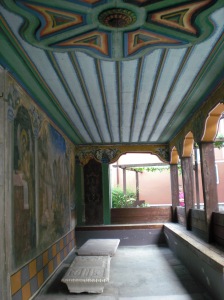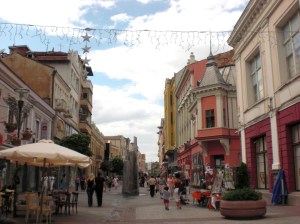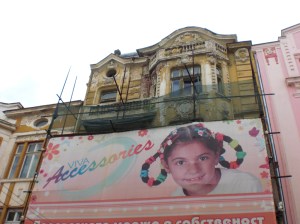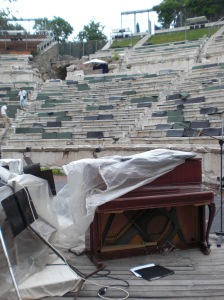PLOVDIV 7/5 to 7/7
The Bulgarian rural landscapes are incredibel. In Turkish, the word ‘Balkan’ translates to ‘a chain of wooded mountains,’ and Bulgaria fits this definition very well. The trip from Veliko Tarnovo to Bulgaria’s former capitol, Plovdiv, was no exception. Although we were trapped in a mini bus that seemed to stop frequently for lunches and snacks, I was in good company, so the trip was enjoyable. I had met Erich at the hostel in Veliko Tarnovo; he came all the way from Northern California where he specializes in making pizzas and poetry. This was his first time in Europe and he was only traveling to the eastern regions. Pretty bold!
That night I stayed with a couchsurfing host, Elina, a 24-year-old Hematologist. Isn’t that incredible? Apparently med school in Bulgaria starts immediately after high school, but I was still impressed that she was already practicing at her age. She had heard of Ann Arbor because of the “Ann Arbor classification,” which I suppose is something doctory. She was extremely nice, very intelligent, and had an amazing apartment not too far from the center. Although she had just gotten off of work, she made us a traditional Bulgarian meal of scrambled eggplant mash from her mother’s garden (“my mother makes everything herself because she doesn’t believe the market vegetables have chemicals”), and a soft white cheese that was incredibly delicious.
“It’s because of this cheese that I could never move away from Bulgaria” she told me, smiling.
Elina spoke almost perfect English, as well as German, and was currently tackling French. She was well-traveled and frank about her study/work abroad experiences. “I had a very bad time in Japan.. and in Jamaica” she told me, which I found refreshing. Usually people say things like “Yeah, I was in Japan it was AWESOME!” even if they were homesick as all get-out. Her next goal is to learn to surf, either in Spain or Australia. I’m always interested to meet people on a fast professional track who haven’t lost their wanderlust.
Elina was very critical of the many young Bulgarians who move to other countries in Europe. She’s happy living in Plovdiv and Bulgaria in general. “There are opportunities here, and things are getting better all the time” she told me. We had a conversation about sex trafficking, which is something that’s still a hot-button issue; Bulgaria’s geographic position between Europe and Asia makes it an excellent entry point. Elina believes that the Bulgarian politicians are still turning a blind eye to the issue while being paid-off, just as in the communist years. We talked more about Bulgaria’s transition from communism to democracy. Just as Emilia and Mary in Veliko Tarnovo had told me, Elina confirmed that most older people remember communism as a simpler and happier time. Bulgaria was a ‘model student’ of communism, one that had an excellent relationship with Russia and adapted to communist practices effectively. Examples of ‘bad students’ are Poland, Slovenia, Hungary, she told me, so their transition to democracy and the EU was perhaps easier. However, Bulgaria’s joining the EU has affected her very positively. She has been able to take advantage of the EU’s ERASMUS student exchange programs.
After bidding farewell to Elina the next morning, I was able to spend the next 24 hours exploring the crazy artistic city of Plovdiv, once the former capitol and now a cosmopolitan university town that I enjoyed more than Veliko Tarnovo or Sofia. The city filled with art galleries and sculptures and it’s also surrounded by four foothills, which are great for getting a good view. Apparently there were seven foothills until the communists leveled the other three to make some room to build.
I think Plovdiv is definitely underrated in terms of its touristic potential, as most tourists seem to merely pass through for a night on their way to Istanbul. There was a budget hotel in the center of town offering double rooms for only 9.00 euro a person, which I found impressive. The city was incredibly colorful—once you get past an awkwardly vast and empty square, the rest of the center is a pedestrian zone, leading to a large underground amphitheater (one of 2 in the town), which his currently covered by a glass surface.
Cafes lined the main drag and the buildings were colorfully painted. Shopping seemed like a popular activity—a lot of store windows were pushing a wide variety of styles, colors, and patterns, and it was fun to see what sorts of combinations people came up with. My impressions of Plovdiv fashion: the men, many of whom were unfortunately round and bald, seemed to prefer some sort of tight-fitting Adidas or Kappa shirt, paired with exercise shorts or capris. They might then choose to accessorize with an around-the-shoulder bag. Rule of thumb: the bigger the belly, the tighter the shirt.
For the women: the less fabric the better, lots of strappy, tight-fitting, colorful clothing; rhinestones and slogans seemed to be favored. I liked how this off-beat fashion added the the atmosphere of the architecturally quirky Plovdiv.
Walking towards the old town was perhaps my favorite part of the visit. Signs of every shape and neon color hung from buildings, which ranged from crumbling to brand new. I loved how hectic it was: a flower stand run by Grandma next to a sex shop, for example. The old town itself was one of the best parts. Although it seemed like no one actually lived there anymore, the colorfully painted traditional Bulgarian houses, were the cutest thing. Erich and I spent the day walking around together. iIt was nice having companionship and conversation for a short time.
 Then we found the Roman Amphitheater! It was amazing. Set high in the old town, it overlooked the entire city of Plovdiv with the Rodopi mountains looming in the distance. After paying the 3 leva entrance (just 1.5 euro) we could walk around anywhere, and I mean anywhere. You would definitely not be able to walk around something as ancient in most parts of Western Europe—it would be akin to having free reign of the Colosseum in Rome. Big pieces of carved Roman rock were strewn about, and the stage was set for a classical music performance, which was apparently scheduled to happen later.
Then we found the Roman Amphitheater! It was amazing. Set high in the old town, it overlooked the entire city of Plovdiv with the Rodopi mountains looming in the distance. After paying the 3 leva entrance (just 1.5 euro) we could walk around anywhere, and I mean anywhere. You would definitely not be able to walk around something as ancient in most parts of Western Europe—it would be akin to having free reign of the Colosseum in Rome. Big pieces of carved Roman rock were strewn about, and the stage was set for a classical music performance, which was apparently scheduled to happen later.
The musical equipment had definitely not been taken very good care of. It was about to rain but the old upright piano was sitting there half-covered with a tarp, while music stands were plugged in and rusting.
Gold confetti was strewn over the ground, but it was clear that it has been there quite awhile. The stairs to the amphitheatre were steep, made of slippery marble and worn in after centuries of stepping, and I simply couldn’t imagine a bunch of elderly people trying to find their seats for an opera performance. We stopped and had a cider at the cafe whose seats lined the outer edge of the amphitheater. Erich and I discussed how a few months ago, neither of us knew that sitting around a Roman amphitheatre in Plovdiv would be in the cards. Honestly, I probably wouldn’t have been able to explain exactly where Bulgaria was on a map.
That night I met two American girls, Elan and Molly, at the hostel. At first I was kind of annoyed that both of my Bulgarian hostels had been crawling with Americans, but these girls were interesting and were doing farming work around Europe. I invited them to come with me to meet Stefan, another couchsurfer who was a Plovdiv native and had offered to take me out for a drink. Stefan met us at the hostel; he was tall, funny and spoke good English. He ended up giving us an impromptu evening walking tour. You could tell he loved his city when he told us about the history of the buildings, what periods they were built in and by whom. It was very nice and informational, and eventually we ended up at a bar that Stefan described as “alternative.”
He’s against Chalga music, which is all the rage in Bulgaria. Chalga combines traditional melodies with dance music, and apparently idiotic lyrics. “Smart people do not listen to Chalga!” said Stefan, almost livid, as he expounded on his hatred. He explained that the secret of Chalga culture is that the singers are actually high-paid prostitutes. So of course they promote a plastic-surgery, silicon ideal that’s not a good influence for the young people.
He took us to a bar in a traditional Bulgarian building. Metallica was blasting, and the crowd was definitely metal. Stefan requested the song “Down with the Sickness.” “For me, there is no other choice!” he said. He was a pretty clean-cut guy, so I thought this was funny. A group of friends nearby were having a grand old time taking turns picking each other up and slapping each others butts playfully. I tried mentha, a light mint liquor that is typical Bulgarian. It was excellent and stronger than I had expected, but not as thick as schnapps. The night went on for a while until the three American’s had to surrender due to extreme tiredness. It was a great stay in Plovdiv!


















Leave a comment